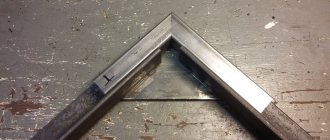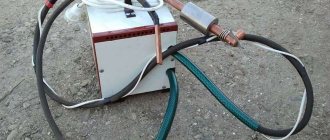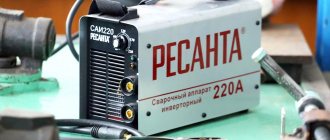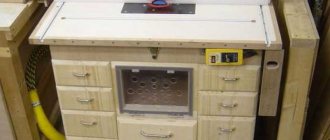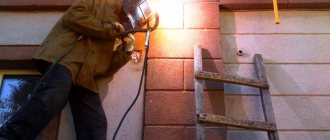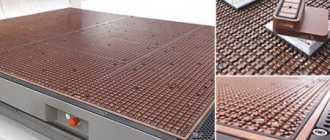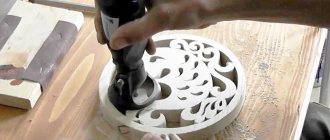Magnetic table for a milling machine: design and characteristics, operating principle
If your work depends on working on a milling machine, then increasing the number of products should be a priority for you. A magnetic plate will be a good tool for increasing productivity.
A magnetic plate for a milling machine will allow you to process more than one part at once, unlike standard jaws. And processing will be carried out with utmost precision and efficiency. Let's take a closer look at all the features of this device.
What is a magnetic plate?
Magnetic plates are a special type of equipment for milling machines, which is needed for processing metal elements, which is necessary for fixing metal elements on the working surface of the machine under the influence of electromagnetic attraction.
Before their appearance, cams were actively used to hold workpieces, which ensured maximum retention during operation. But still, magnetic plates have a number of more outstanding advantages compared to cams:
- there is an alternative to processing several workpieces at once;
- the maximum precision of the impact is ensured, which is associated with the phenomenon of heating the metal part. It expands, but does not deform like a part in clamps;
- provide high reliability of fastening;
- maintain basic performance characteristics at the original level for the entire period of use;
- do not require annual (or more often) technical inspection and repair activities.
But these devices also have disadvantages:
- not used in work that requires high cutting force;
- residual magnetism of workpieces made of steel, but a demagnetizer will help cope with this feature.
Reference! Demagnetizer (demagnetizer) - is necessary to deprive the attractive forces of a tool or workpiece so that metal shavings do not stick to it.
Magnetic plates are most often used on grinding, milling and lathes for processing metal-containing products.
Important!
Magnetic plates are very rarely included in the basic equipment of the machine, so they must be purchased and installed separately, taking into account the necessary parameters of the product.
Design Features
The main structural elements of a magnetic plate for a milling machine are:
- The body of the device is made from soft steel. Its base has special oppositely charged protrusions.
- A special lid that covers the work surface. The cover is one pole, and the remaining surface is the opposite pole.
- Coils - designed to pass direct current.
- A magnetic block is a movable element that moves due to the work of an eccentric top.
Specifications
Technical conditions for the production of magnetic plates are regulated by GOST 16528-87 . It describes all the characteristics of stoves with different types of control.
The main parameters affecting the operation of magnetic plates are:
- Overall dimensions – minimum starting from 10x25 cm and maximum up to 32x100 cm. The final dimensions of the workpiece depend on this value. Also, the significant size of the plate increases the load on the machine’s work table.
- Magnetic force - acts constantly and when not in working position it is prevented by blocks of non-magnetic material. The range of action of this value is 50–120 N/cm².
- The distance between magnetic poles or coils. The smallest size available for the part being manufactured depends on it.
Operating principle of a magnetic table
The principle of operation of the stove is quite simple and understandable. A magnetic field is formed on its working surface, which fixes metal workpieces. Thanks to this function, it becomes possible to process not only the outer part of the materials, but also the side areas.
If necessary, simultaneous processing of several parts is available. Thanks to its magnetic properties, you can install additional tools on the work surface that will be useful in your work.
User manual
The magnetic plate should be re-opened and the equipment passport should be examined.
- Place it on the machine table.
- Check that the mounting is correct and start working.
- A workpiece made of ferromagnetic material must be placed on the working surface in the required position and the lever must be rotated 180 degrees. Check the reliability of the fastening.
- Start processing the workpiece.
- Metal shavings generated during operation can be removed with a brush after turning the handle 180 degrees. Then, after cleaning the surface, you need to fix the workpiece again using the handle.
- Upon completion of work, turn the handle and remove the workpiece.
Important!
The impact of a shock load on a workpiece fixed on a magnetic plate is unacceptable, since this leads to a decrease in the magnetization of individual elements and, accordingly, to a decrease in the attractive forces of the plate as a whole.
Expert advice and price
The best-selling models of magnetic plates are:
- MP 400x125 sinus 2S7208-0003. Its advantage is the reliable clamping of workpieces using the magnetic currents of permanent magnets, which guarantees a constant clamping force throughout the entire operation. The price of such a device is from 50 thousand rubles.
- MP 250x100 (7208-0001) – slightly cheaper than the previous model, sold from 19 thousand rubles.
- MP flat X91 300x680 (66120-6) – makes it possible to process parts with a minimum thickness of 8 mm/7 mm. Its cost is from 170 thousand rubles.
It provides reliable fixation of the workpiece, which affects the quality of the work. Another good thing about this device is that the technical parameters and possibilities for using such a design remain the same over time. This quality arouses buyers’ interest in electromagnetic cookers.
Technical specifications
Magnetic plates are rarely included as standard equipment in factory equipment. Most often they are purchased separately. Therefore, it is important to know their main technical characteristics, which must correspond to the parameters of a specific machine model.
The determining parameter is the dimensions. The size of the plate can vary from 10*25 cm to 32*100 cm. Moreover, as the dimensions of the device increase, its weight increases. This directly affects the maximum weight of the workpiece, since the plate is installed on a standard work table.
The main parameters that a magnetic plate should have:
- dimensions and weight. Not only width and length are taken into account, but also height. It may affect the maximum permissible part size;
- specific force of attraction. It must be uniform over the entire installation plane. Typically this parameter ranges from 50 to 120 N/cm²;
- distance between poles. This characteristic determines the minimum size of the workpiece.
During operation, the magnetic plate can change the geometry of the workpiece. Therefore, the process of installing and subsequently removing the part should be as careful as possible. You should also take into account the main disadvantage of electromagnetic models - heating of the surface during activation. This is not only the main reason for device failure, but also affects the properties of the workpiece.
The video shows an example of how a small magnetic plate works:
Making a surface grinding machine with your own hands
A surface grinding machine, which you can make yourself, is a very popular piece of equipment not only in manufacturing enterprises, but also in the home workshop.
Such a device is practically indispensable in situations where it is necessary to grind and adjust metal parts.
Of course, such work can be done manually, but this will take a lot of effort and time and will not allow achieving high precision processing.
Processing a workpiece on an industrial surface grinding machine
It makes sense to think about equipping your home workshop with a surface grinding machine if you often have to work on metal.
In this case, you can choose one of two options: buy serial equipment or make such a machine yourself.
The purchase of a serial machine is associated with serious financial costs, which is not always advisable for its use in a home workshop.
A homemade surface grinding machine will cost much less. Of course, the functionality of such equipment will be somewhat lower than that of serial equipment, but its capabilities will be quite sufficient to perform metal work at home.
How do surface grinding machines work?
The vast majority of parts made of metal undergo a technological operation such as grinding. To perform this with high efficiency and accuracy, surface grinding machines are used.
A rather difficult to manufacture banding machine with excellent functionality
General view of the machine Design of the work table drive
Surface grinding machines of serial models can process both flat and profile parts. The surface processing accuracy that can be achieved using such devices is 0.16 microns.
Of course, it is almost impossible to achieve such a result when processing on machines made by yourself.
However, even the accuracy that homemade machines allow to obtain is quite sufficient for many metal products.
The load-bearing structural element of the machines of this group (as well as any other equipment) is the bed. Its dimensions directly determine what size parts can be processed on the machine.
The most common material for manufacturing beds of surface grinding equipment is cast iron, since this metal, due to its characteristics, perfectly dampens vibrations, which is especially important for devices of this type.
Work table and controls of the 3G71M grinding machine
The structural element of surface grinding machines on which the workpiece is fixed is a work table having a round or rectangular shape.
Its dimensions can vary significantly depending on the specific model of surface grinding equipment. The workpieces can be fixed on such a work table due to its magnetized surface or using special clamping elements.
During processing, the work table makes reciprocating and circular movements.
In mass-produced surface grinding machines, the work tables are driven by a hydraulic system. In self-assembled equipment, mechanical transmissions are used for this.
Grinding a steel workpiece fixed on the working surface of the machine using a magnetic field
Important elements of the design of surface grinding equipment, which ensure the accuracy and smooth movement of the work table, are guides. In addition to high precision manufacturing, the guides must have exceptional strength, since in the process of almost constant movements of the desktop they are subject to active wear.
To achieve high processing accuracy, the guides must ensure accurate, smooth (without jerking) movement of the worktable with minimal friction of the contacting elements. That is why high-strength steel is used for the manufacture of these structural elements, which is hardened after the guides are made from it.
Option for manufacturing guides using angles and bearings
The working tool of a surface grinding machine, which can be a grinding wheel or an abrasive belt, is mounted on the spindle of the headstock. Rotation of the working tool, for which the main electric motor is responsible, can be transmitted through a gearbox or belt drive.
For do-it-yourself surface grinding machines, you can choose a simpler option: select the diameter of the grinding wheel so that it can be mounted directly on the electric motor shaft. This will eliminate the need to use a gear or belt drive.
Recommendations for making a surface grinding machine with your own hands
Serial surface grinding machines, in addition to their high cost, are also distinguished by their large dimensions. Not every workshop can accommodate such a machine, which also limits their use at home. That is why many craftsmen prefer equipment made by themselves.
Many structural elements for making a surface grinding machine can be found in your workshop or garage, but some of them will still have to be purchased additionally. These are materials and devices such as:
- metal corners of two types - 50x50x5 and 25x20x1.5 (their total number will depend on the size of the machine you are going to make);
- pipes with a wall thickness of 2 mm or more, made of stainless steel;
- main electric motor, the shaft rotation speed of which is 1400–1500 rpm;
- a magnetic plate, the dimensions of which will also depend on the dimensions of the parts that you are going to process;
- 4 bearings and a set of ball screws;
- rail type guides;
- grinding wheel;
- end supports in the amount of 2 pcs.
Working surface of the machine with a homemade clamping device
General view of a homemade device Design of lifting the working surface
Do-it-yourself manufacturing of a surface grinding machine begins with a frame, the frame of which is assembled from corners, cut to the required sizes and connected by welding. To increase the ability of the bed to absorb vibrations that occur during operation of the machine, a sheet of chipboard can be mounted into its lower part.
The next structural piece of equipment that will need to be manufactured is the work table, which uses a 4mm sheet of steel welded to the top of the frame.
Rail guides are fixed on the surface of the finished desktop, which must be highly durable and manufactured accurately.
Such guides can be purchased ready-made or ordered from a qualified milling machine operator.
Magnetic plate for grinding machine
A carriage will move along the worktable guides, on which a magnetic plate or a special clamping device is placed. The carriage is also made by hand from corners, which are cut to the required sizes and connected by welding.
Wheels and ball screw elements are fixed to the carriage using screw connections. A screw with a handle, which will be responsible for moving the carriage, is installed in bearing supports, fixed at both edges of the desktop.
Finally, a magnetic plate or clamping device must be fixed to the carriage.
Homemade surface grinding machine with an abrasive wheel as a working part
Homemade belt type grinding machine
The electric motor, on the shaft of which the grinding wheel is fixed, will move in the vertical direction using two guides.
As the latter, you can use stainless steel pipes welded to the frame.
The vertical movement of the metal plate base on which the electric motor will be fixed is communicated using ball screw elements.
One transmission support is fixed at the top of the guide pipes, and the second at the base itself.
To ensure the rotation of the grinding wheels, you can use electric motors from old washing machines or vacuum cleaners.
After the entire structure is assembled, you need to connect power to the motor, lubricate all the guides and perform a test run of your homemade surface grinding equipment.
Such a machine, if desired and necessary, can be modernized without problems by supplementing its design with devices that expand its functionality.
Making a tabletop with lighting from New Year's garland
There is an easier way to make your own table with an infinity effect. In this case, instead of an LED strip, a regular New Year's garland is used. First, a square or rectangular frame is made from bars, then the number of light bulbs on the garland is counted.
After this, marks are placed on the frame in the places where the light bulbs will be located. It is recommended to place them at a distance of about 2 cm from each other. At the next stage of work, holes for light bulbs are drilled in the frame of the future table.
Then light bulbs are inserted into these holes and secured there. Then you need to glue the frame onto the mirror with your own hands, and glue glass with a mirror film on top of the frame.
DIY magnetic plate - Metals, equipment, instructions
Magnetic plates for grinding machines are a special class of metalworking equipment that is designed to hold steel workpieces on the working surface under the influence of electromagnetic attraction forces.
It would seem, why use such a sophisticated design when you can use traditional cams as a clamp, which reliably clamp the workpiece and provide maximum rigidity during processing? In fact, electromagnetic fixation using magnetic plates for grinding machines has a number of advantages, which we will discuss below.
The key advantage is the ability to operate the equipment in multi-threaded mode. The master can simultaneously fix several workpieces on one installation, thereby increasing the productivity of his work by an order of magnitude. In addition, the magnetic plate for the grinding machine can ensure extreme precision in machining the workpiece.
This is due to the fact that during the grinding process the metal part heats up and, accordingly, expands. In this case, the workpiece clamped in a vice is deformed, while the workpiece mounted on the electromagnetic plane expands freely on the working surface.
It is worth remembering that the plate is not capable of providing as much force as the locking cams. In addition, if an emergency interruption of the power supply occurs, the workpiece will fall off the working surface. That is why the scope of application of magnetic plates for grinding machines excludes work that requires high cutting forces.
Another disadvantage of such installations is the phenomenon of residual magnetism inherent in steel workpieces that were processed in this way. Fortunately, you can cope with the problem using a demagnetizer, which in most cases allows you to close your eyes to the above-described drawback.
Design and operating principle
The housing, the most important part of the design of the magnetic plate for the grinding machine, is made of mild steel. Its bottom has special pole protrusions. The working surface of the plate is covered with a special cover, sections of which are located above the poles and separated by special non-magnetic layers. Direct current is passed through the coils.
In this case, the outer surface of the table acts as one pole, and the remaining part of the surface represents the opposite pole. A metal part that covers the non-magnetic layer at any point on the slab closes the magnetic flux and is fixed on the surface.
The force of attraction is an important parameter to consider when working with a magnetic holding surface. It largely depends on the dimensions of the fixed structure and the material from which it is made.
In addition, the force of attraction is influenced by the number of parts attached to the installation, as well as the design of the plate itself. Where the master placed the workpiece also affects this parameter.
The force of attraction is measured in N/cm2. The optimal parameter value is from 20 to 130 N/cm2.
Every craftsman should remember that the magnetic plate for a grinding machine heats up during operation. Frequent changes in the temperature of the structure can lead to the formation of condensation inside.
Engineers involved in the design of such units carefully consider a system for protecting the coils from unwanted exposure to liquid.
Bitumen, which is factory-poured into the internal cavity of the electromagnetic table, allows you to cope with this kind of task.
The magnetic block is an important part of the design. This movable element is moved by the operation of an eccentric top. The magnetic plate functions only when switched on. It will delight the craftsman with its operational capabilities and ensure the most even placement of the product on the working surface, which will immediately affect the accuracy of the final result.
Results
A magnetic plate for a grinding machine is capable of reliable fixation of the workpiece, which affects the quality of the task.
It is interesting that the technical parameters and operational capabilities of this design do not change over time and as the service life of the equipment increases.
This, in part, provokes increased interest in electromagnetic cookers from potential buyers.
As an additional advantage of the magnetic plate, it is worth noting that it does not require additional maintenance. If you follow the basic operating rules, it can last for decades without losing its functionality.
If you are looking for ways to increase productivity at your grinding machine, it’s time to think about purchasing an electromagnetic unit. Unlike standard jaws, this design allows you to process multiple parts at once with extreme precision and efficiency. All this is confirmed by the practice of tens of thousands of masters.
How to make a simple electromagnet - step-by-step instructions with diagrams
Such a device is convenient because its operation is easy to control using electric current - changing the poles, changing the force of attraction. In some matters it becomes truly indispensable, and is often used as a constructive element of various homemade products. It’s not difficult to make a simple electromagnet with your own hands, especially since almost everything you need can be found in every home.
What you will need
- Any suitable sample made of iron (it is highly magnetic). This will be the core of the electromagnet.
- The wire is copper, always with insulation to prevent direct contact of the two metals. For a homemade electric magnet, the recommended cross-section is 0.5 (but not more than 1.0).
- DC source - battery, battery, power supply.
Additionally:
- Connecting wires for connecting an electromagnet.
- Soldering iron or electrical tape to secure contacts.
DIY magnetic plate
Magnetic plates for grinding machines are a special class of metalworking equipment that is designed to hold steel workpieces on the working surface under the influence of electromagnetic attraction forces.
It would seem, why use such a sophisticated design when you can use traditional cams as a clamp, which reliably clamp the workpiece and provide maximum rigidity during processing? In fact, electromagnetic fixation using magnetic plates for grinding machines has a number of advantages, which we will discuss below.
The key advantage is the ability to operate the equipment in multi-threaded mode.
The master can simultaneously fix several workpieces on one installation, thereby increasing the productivity of his work by an order of magnitude.
In addition, the magnetic plate for the grinding machine can ensure extreme precision in machining the workpiece.
This is due to the fact that during the grinding process the metal part heats up and, accordingly, expands.
In this case, the workpiece clamped in a vice is deformed, while the workpiece mounted on the electromagnetic plane expands freely on the working surface.
It is worth remembering that the plate is not capable of providing as much force as the locking cams.
In addition, if an emergency interruption of the power supply occurs, the workpiece will fall off the working surface.
That is why the scope of application of magnetic plates for grinding machines excludes work that requires high cutting forces.
Another disadvantage of such installations is the phenomenon of residual magnetism inherent in steel workpieces that were processed in this way. Fortunately, you can cope with the problem using a demagnetizer, which in most cases allows you to close your eyes to the above-described drawback.
Do-it-yourself induction heaters - how to make? Simple diagram and instructions
Induction heaters work on the principle of “derived current from magnetism”. A high-power alternating magnetic field is generated in a special coil, which generates eddy electric currents in a closed conductor.
The closed conductor in induction cookers is a metal cookware, which is heated by eddy electric currents.
In general, the operating principle of such devices is not complicated, and if you have a little knowledge of physics and electrical engineering, assembling an induction heater with your own hands will not be difficult.
The following devices can be made independently:
- Devices for heating the coolant in a heating boiler.
- Mini furnaces for melting metals.
- Cooking plates
A do-it-yourself induction cooker must be manufactured in compliance with all standards and regulations for the operation of these devices. If electromagnetic radiation dangerous to humans is emitted outside the housing in lateral directions, then the use of such a device is strictly prohibited.
In addition, the great difficulty in designing a stove lies in the selection of material for the base of the hob, which must meet the following requirements:
- Ideally conduct electromagnetic radiation.
- Not a conductive material.
- Withstand high temperature load.
Magnetic plate for convenient sanding of small parts
Hello, dear readers and DIYers! Surely almost every one of you has encountered the need to process small steel workpieces, and knows that even simple grinding of small parts can cause inconvenience.
In this article, the author of the “TOKARKA” channel will tell you how he made a special magnetic plate, with the help of which this process will be much simpler, easier, and most importantly safer.
Materials—Aluminum block
- Neodymium magnets
— Two-component acrylic adhesive— Stainless steel sheets— M2 brass screws— Machine oil
Tools used by the author.
— Hacksaw— Milling machine
— Tap
— Dremel — Screwdriver, metal drills — Automatic core
— Construction hair dryer
- Vise, caliper, file, screwdriver.
Manufacturing process.
So, a large aluminum block like this is suitable as a body. It has excellent thermal conductivity and will protect the magnets from overheating. The wooden case is not suitable for this homemade product.
Having fixed the block in a vice, the master cuts off a workpiece of suitable size from it.
The surfaces of the block are leveled on a milling machine, although this can also be done with a regular file.
At one end of the workpiece, grooves for magnets are milled. The author will use rectangular magnets. And if it had round magnets, then this procedure would be much simpler, and it would be possible to do without a router.
So, these are the separators we got. He made the central one a little wider than the others; a clamping screw will be screwed into it.
These are neodymium magnets with dimensions of 20X10X5 mm.
They will be glued using epoxy resin; you can also use two-component second glue. Before gluing, it is better to slightly warm up the workpiece so that the epoxy resin fills the cracks better.
The author made a mistake, and when trying to glue in a second magnet, it jumped out and became magnetized to the first one. The gluing process became much easier when he used a plastic card, pressing it against each subsequent magnet.
After some time, the resin has polymerized, and the craftsman begins making the protective plate. He will make it from stainless non-magnetic steel. Immediately checks how it passes the magnetic field.
Transfers the markings to the plate with a steel scriber.
In order to accurately cut the strip, he magnetized it to a file and cut it with a Dremel.
Holes are drilled in the plate and body and an M2 thread is cut.
The holes on the plate are countersunk, and it is screwed to the body using brass screws.
In a recent article, the author told how he made such a powerful semi-automatic core. He uses it to mark two steel plates.
Drills holes for M3 bolts in them and the body, and taps them.
The holes in the plates are milled; they must be made elongated.
Next, the surfaces of the body and plates are ground.
Thrust plates are screwed to two side walls; they will be adjustable to the thickness of the workpiece.
This is how you can easily adjust them so that the surface of the part protrudes above the stops.
Without such a magnetic plate, the grinding process was extremely inconvenient; the part could slip off, and the fingers would solemnly fall on the moving abrasive belt. It is strictly forbidden to perform such work while wearing gloves.
So, the device is ready, and now everything has become much more convenient and safer. You can place a block under the device itself.
Here is the result of sanding, everything is fine.
You can also process parts on a grinder with a grinding disc attachment.
A screwdriver with an abrasive disc or a small hand-held sander will also work.
This device can be fixed in a vice and the parts can be processed manually. The pull-off force, provided the workpiece covers all 10 magnets, will be about 40-45 kilograms. And sawdust that gets on the surface can be easily removed with a damp cloth. The master also noticed that the parts do not become magnetized after processing.
I thank the author for a simple but useful device for the workshop! Good mood, good luck, and interesting ideas to everyone!
The author's video can be found here.
Source
Become the author of the site, publish your own articles, descriptions of homemade products and pay for the text. Read more here. (Visited 8 times, 1 visits today)
About the author
How to make a powerful electromagnet
An electromagnet is a magnet that works (creates a magnetic field) only when electric current flows through a coil. To make a powerful electromagnet, you need to take a magnetic core and wrap it with copper wire and simply pass current through this wire. The magnetic core will begin to be magnetized by the coil and begin to attract iron objects. If you want a powerful magnet, increase the voltage and current, experiment. And so as not to have to worry about assembling the magnet yourself, you can simply remove the coil from the magnetic starter (they come in different types, 220V/380V). You take out this coil and insert a piece of any piece of iron inside (for example, an ordinary thick nail) and plug it into the network. This will be a really good magnet. And if you don’t have the opportunity to get a coil from a magnetic starter, then now we’ll look at how to make an electromagnet yourself.
Do-it-yourself electromagnetic table - Metalist's Handbook
Magnetic plates for grinding machines are a special class of metalworking equipment that is designed to hold steel workpieces on the working surface under the influence of electromagnetic attraction forces.
It would seem, why use such a sophisticated design when you can use traditional cams as a clamp, which reliably clamp the workpiece and provide maximum rigidity during processing? In fact, electromagnetic fixation using magnetic plates for grinding machines has a number of advantages, which we will discuss below.
The key advantage is the ability to operate the equipment in multi-threaded mode. The master can simultaneously fix several workpieces on one installation, thereby increasing the productivity of his work by an order of magnitude. In addition, the magnetic plate for the grinding machine can ensure extreme precision in machining the workpiece.
This is due to the fact that during the grinding process the metal part heats up and, accordingly, expands. In this case, the workpiece clamped in a vice is deformed, while the workpiece mounted on the electromagnetic plane expands freely on the working surface.
It is worth remembering that the plate is not capable of providing as much force as the locking cams.
In addition, if an emergency interruption of the power supply occurs, the workpiece will fall off the working surface.
That is why the scope of application of magnetic plates for grinding machines excludes work that requires high cutting forces.
Another disadvantage of such installations is the phenomenon of residual magnetism inherent in steel workpieces that were processed in this way. Fortunately, you can cope with the problem using a demagnetizer, which in most cases allows you to close your eyes to the above-described drawback.
Rectangular magnetic plate passport (Х41000-220 or Х41150-400)
Rectangular magnetic plates are intended for securing ferromagnetic workpieces during processing on surface grinders, milling, planing and other machines, as well as as independent devices when performing metalworking, welding, marking, assembly, inspection and other work.
